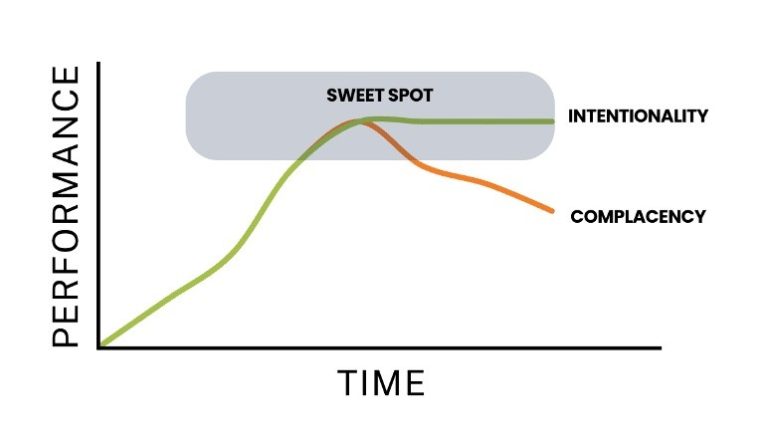- 0
- United States
Author: Michelle "Mace" Curran
Is Complacency Putting You Risk? Lessons From a Fighter Pilot
Flying taught me a valuable lesson about life: complacency can cause serious problems for ourselves and those around us. In this newsletter, share a personal story about the dangers of complacency including the following topics:
- Complacency Consequences
- What leads to complacency?
- Signs Complacency is Creeping In
- Steps to Avoid Complacency
What am I going to have for dinner tonight?
Seems like an innocent question.
Now imagine you caught yourself asking that question, but while flying feet away from another aircraft moving at several hundred miles per hour.
Suddenly realizing I was doing this was a wake-up call. I had just entered the most dangerous level of proficiency, the point where complacency replaces vigilance. When first learning to fly, you find yourself at the opposite end of the spectrum, where the danger level is also high.
Early on your skill level is low, the learning is challenging, and you can find yourself in a state of extreme stress. There is a good chance your performance will suffer. After a while, your proficiency increases, you can manage the stress, and you are in the sweet spot of competence. However, if you aren’t careful, it is easy to slip from the sweet spot into complacency.
Complacency Putting You Risk
Complacency Consequences
The dangers of complacency extend beyond the skies. History provides us with several world-wide examples of catastrophic outcomes resulting from complacency, such as the Space Shuttle Challenger disaster, the 2007-2008 financial crisis, and the Chernobyl nuclear accident.
Complacency can also creep into our everyday lives, affecting activities like driving a car, operating machinery, or monitoring a patient in a healthcare setting. The consequences of complacency can be severe and far-reaching.
What leads to complacency?
Complacency can emerge from various factors. Success and past achievements can breed a false sense of security, making us believe that we are infallible.
Routine and familiarity can also contribute, as we become so accustomed to a task that we stop critically assessing the risks involved.
Lack of feedback is another factor, as without constructive criticism, we may overlook areas for improvement.
Complacency can also arise when individuals or organizations lack challenging goals, competition, or fail to foster a culture of constant improvement.
Signs Complacency is Creeping in
Recognizing red flags and warning signs that indicate complacency is crucial in maintaining peak performance and safety in any field. Here are some key indicators to be mindful of:
Decreased Attention to Detail: When individuals start overlooking minor errors or neglecting routine checks, it may signal a decline in their vigilance and focus.
Resistance to Feedback: A reluctance to seek or accept constructive criticism can be a sign that complacency is setting in, as it suggests a lack of interest in self-improvement.
Overconfidence: Excessive confidence in one’s abilities, especially based on past successes, may lead to underestimating potential risks and not taking necessary precautions.
Lack of Initiative: A decrease in proactive behavior and a failure to take on new challenges or responsibilities may indicate a comfort zone has been established, breeding complacency.
Inconsistent Performance: When a consistent level of excellence starts to wane, it could be an indication that complacency is affecting overall performance.
Repeated Near-Miss Incidents: Ignoring or downplaying near-miss incidents instead of learning from them can suggest a dismissive attitude towards potential hazards.
Disregard for Protocols: Failure to adhere to established protocols or bypassing safety procedures may be a manifestation of complacency.
Paying attention to these warning signs helps people and organizations recognize complacency early on and take proactive steps to ensure they maintain top-notch performance and safety.
Steps to Avoid Complacency
To actively avoid complacency in both professional and personal spheres, consider the following steps:
Set Challenging but Achievable Goals: Continuously challenge yourself by setting ambitious but realistic goals. These objectives will drive you to stay focused and motivated.
Seek Constructive Criticism: Embrace feedback from peers and mentors to identify areas for improvement and refine your skills.
Continuous improvement should be a constant pursuit.
Healthy Competition: Foster healthy competition within the organization. Competing with others and striving to outperform can keep complacency at bay.
Stay Curious and Open to Innovative Ideas: Remain open-minded to new and innovative ideas, both in your profession and daily life. Embracing change can lead to significant advancements.
Establish Intentional Procedures and Protocols: In fields where consistency and safety are paramount, create intentional protocols to ensure that complacency doesn’t lead to oversights.
Recognize the Need for Breaks: Avoid extreme fatigue by recognizing the importance of taking breaks and allowing time for rest and recuperation.
Conclusion
Flying taught me a valuable lesson about life: complacency can cause serious problems for ourselves and those around us. However, we can take charge and avoid this trap. By setting challenging goals, embracing a learning mindset, seeking feedback, and being open to growth, we can maintain high levels of performance.
We all must find our way through the first phase of learning, low competence, and heightened stress. Once you settle into the sweet spot, it is possible to stay there, but you’ll need to be intentional. Let’s apply these lessons to our lives and professions for a safer and more successful future.
Contact Us at WeSpeak Global and click here to find more Motivational Speakers
Category
- Empowerment
- Leadership
- Mindset
- Motivation
City | Country
- United States
Disclaimer: The articles, video and images embedded on these pages are from various speakers and talent.
These remain the property of its owner and not affiliated with or endorsed by WeSpeak Global.
Similar to Complacency Putting You Risk
There are no results matching your search.
Reset











